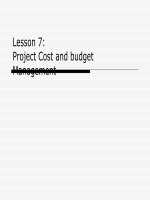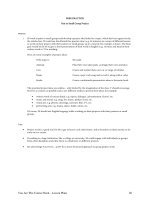Lesson 09 Project Reports
Bạn đang xem bản rút gọn của tài liệu. Xem và tải ngay bản đầy đủ của tài liệu tại đây (507 KB, 33 trang )
Lesson 9:
Project Report
2
Learning Objectives
Understand the importance of good communications in
projects.
Explain the elements of project communications planning,
including how to create a communications management
plan and perform a stakeholder communications analysis.
Describe various methods for distributing project
information and the advantages and disadvantages of each,
discuss the importance of addressing individual
communication needs, and calculate the number of
communications channels in a project.
3
Learning Objectives (cont’d)
Understand how the main outputs of performance reporting help
stakeholders stay informed about project resources.
Recognize the importance of good communications
management for stakeholder relationships and for resolving
issues.
List various methods for improving project communications,
such as managing conflicts, running effective meetings, using e-
mail and other technologies effectively, and using templates.
Describe how software can enhance project communications
management.
4
Project Communications
Management Processes
Communications planning: Determining the information
and communications needs of the stakeholders.
Information distribution: Making needed information
available to project stakeholders in a timely manner.
Performance reporting: Collecting and disseminating
performance information, including status reports, progress
measurement, and forecasting.
Managing stakeholders: Managing communications to
satisfy the needs and expectations of project stakeholders
and to resolve issues.
5
Communications Planning
Every project should include some type of
communications management plan, a document that
guides project communications.
Creating a stakeholder analysis for project
communications also aids in communications planning.
6
Communications Management
Plan Contents
Stakeholder communications requirements.
Information to be communicated, including format,
content, and level of detail.
The people who will receive the information and who
will produce it.
Suggested methods or technologies for conveying the
information.
7
Communications Management
Plan Contents (cont’d)
Frequency of communication.
Escalation procedures for resolving issues.
Revision procedures for updating the communications
management plan.
A glossary of common terminology.
8
Information Distribution
Getting the right information to the right people at
the right time and in a useful format is just as
important as developing the information in the first
place.
Important considerations include:
Using technology to enhance information distribution.
Formal and informal methods for distributing
information.
9
Distributing Information in an
Effective and Timely Manner
Don’t bury crucial information.
Don’t be afraid to report bad information.
Oral communication via meetings and informal talks
helps bring important information—good and bad—out
into the open.
10
Understanding Group and Individual
Communication Needs
People are not interchangeable parts.
As illustrated in Brooks’ book The Mythical Man-
Month, you cannot assume that a task originally
scheduled to take two months of one person’s time can
be done in one month by two people.
Nine women cannot produce a baby in one month!
11
Personal Preferences Affect
Communication Needs
Introverts like more private communications, while
extroverts like to discuss things in public.
Intuitive people like to understand the big picture,
while sensing people need step-by-step details.
Thinkers want to know the logic behind decisions,
while feeling people want to know how something
affects them personally.
Judging people are driven to meet deadlines while
perceiving people need more help in developing and
following plans.
12
Other Communication
Considerations
Rarely does the receiver interpret a message exactly as
the sender intended.
Geographic location and cultural background affect the
complexity of project communications.
Different working hours
Language barriers
Different cultural norms
13
Determining the Number of
Communications Channels
As the number of people involved increases, the
complexity of communications increases because there
are more communications channels or pathways
through which people can communicate.
Number of communications channels = n(n-1)
2
where n is the number of people involved.
14
The Impact of the Number of People on
Communications Channels
15
Performance Reporting
Performance reporting keeps stakeholders informed
about how resources are being used to achieve project
objectives.
Status reports describe where the project stands at a
specific point in time.
Progress reports describe what the project team has
accomplished during a certain period of time.
Forecasts predict future project status and progress
based on past information and trends.
16
Managing Stakeholders
Project managers must understand and work with
various stakeholders.
Need to devise a way to identify and resolve issues.
Two important tools include:
Expectations management matrix
Issue log
17
Expectations
Management Matrix
18
Suggestions for Improving Project
Communications
Manage conflicts effectively.
Develop better communication skills.
Run effective meetings.
Use e-mail effectively.
Use templates for project communications.
19
Conflict Handling Modes
1. Confrontation: Directly face a conflict using a
problem-solving approach.
2. Compromise: Use a give-and-take approach.
3. Smoothing: De-emphasize areas of difference and
emphasize areas of agreement.
4. Forcing: The win-lose approach.
5. Withdrawal: Retreat or withdraw from an actual or
potential disagreement.
20
Conflict Can Be Good
Conflict often produces important results, such as new
ideas, better alternatives, and motivation to work
harder and more collaboratively.
Groupthink: Conformance to the values or ethical
standards of a group. Groupthink can develop if there
are no conflicting viewpoints.
Research suggests that task-related conflict often
improves team performance, but emotional conflict
often depresses team performance.
21
Running Effective Meetings
Determine if a meeting can be avoided.
Define the purpose and intended outcome of the
meeting.
Determine who should attend the meeting.
Provide an agenda to participants before the meeting.
Prepare handouts and visual aids, and make logistical
arrangements ahead of time.
Run the meeting professionally.
Build relationships.
22
Using E-Mail Effectively
Make sure that e-mail is an appropriate medium for
what you want to communicate.
Be sure to send the e-mail to the right people.
Use meaningful subject lines.
Limit the content to one main subject, and be as clear
and concise as possible.
23
Using E-Mail Effectively (cont’d)
Limit the number and size of attachments.
Delete e-mail you don’t need, and don’t open e-mail if
you question the source.
Make sure your virus software is current.
Respond to and file e-mails quickly.
Learn how to use important features.
24
Using Templates for Project
Communications
Many technical people are afraid to ask for help.
Providing examples and templates for project
communications saves time and money.
Organizations can develop their own templates, use
some provided by outside organizations, or use samples
from textbooks.
Recall that research shows that companies that excel in
project management make effective use of templates.
25
. Sample Template for a
Project Description









